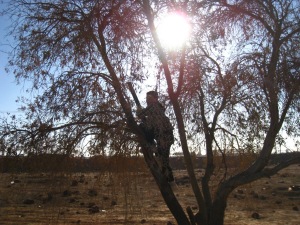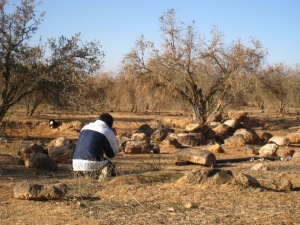This weekend, the OneMinutesJr. awards were announced and “We Walk Their Path,” by Amar, won the One Minute of Freedom award. The film was produced during a workshop I facilitated in Zaatari, the Syrian refugee camp in the north of Jordan.
There are so many stories from that trip – tales of kids uprooted from their homes, remembrances of lost items and childhood adventures, consistent declarations of an eventual return to Syria. All the kids in the workshop lived at Zaatari, some having been there a year and a half already. The majority came from Daraa, a city in southwestern Syria, just north of the border with Jordan. At the time of the workshop, in January 2014, the Zaatari camp hosted about 85,000 refugees from the conflict in Syria.
I had facilitated workshops in over 20 countries at this point, so I was no stranger to challenging work environments. In addition to the physical containment (our movement was extremely limited) and the emotional impact (of witnessing life in the camp), there was the hurdle of general inexperience. Most of the seventeen participants of the workshop had never held a video camera before and their image-taking experience was mostly limited to mobile phones. The ideas behind creating imagery were fairly distant for them. But while they didn’t outright grasp the concepts of filmmaking, their imaginations never lacked.
As you can imagine, there are many stories to be told. But, for now, a focus on Amar (first name only, for security’s sake) and his tale of war.
Amar was a quiet kid, with an air of seriousness to his youthful appearance. Dark-haired with rosy cheeks. Like all the kids, he relayed tales of his home in Syria. Around his house was a lake with geese and ducks, which he used to play with. There were demolished houses nearby and sometimes he and his friends played there with water pistols.
Now, many kids in the world have tales of childhood adventures playing war with neighborhood friends, brandishing water pistols or toy guns in imaginary battles. But with Amar, and so many in his situation, these battles are not born solely from imagination or from television. In Syria, he saw many adults with firearms, was witness to actual conflict. “The children are imitating what the adults do, using water pistols and sticks,” he noted.
In developing his film idea, he also mentioned something else striking: there were camera people taking pictures of action between the army and the rebels. What stuck in his mind was not only the fighting itself, but the media environment that rose around the conflict. And it wasn’t just official media, but people (“whoever was around”) taking pictures with their mobiles, “to show the world what was happening.” So he and filmmakers Taatske Pietersen and Olivia Glebeek decided to make a film about how children imitate war.
“This is exactly what is going on in Syria,” he shared. “Such scenes will remain alive in [the kids’] minds,” he added matter-of-factly. Really think about that. That scenes of violent conflict, possibly dead bodies, are witnessed by young, innocent kids. And that these scenes will remain alive in their minds. What do parents say to their kids when they experience this? The common response, “It’s okay, it’s only a television show. It’s not real,” does not apply here. Yet he was so unemotional, almost practical, when talking about these situations and sights.
So we fashioned guns out of sticks and cardboard and set forth to re-create these scenes in a barren part of the camp just inside the gates. Now, I’ve seen kids play “war.” This was not kids “playing” war. These were actions played out from experience, art imitating life if you will. The way the kids moved, running close to the ground, diving. The way they operated their “toy” guns, transforming them into real firearms. The way they let their bodies fall when they were “shot,” nothing like the fake, staggering forward movements you usually see with children. Seeing those bodies lying in the dirt, so still, so real – it was as if we really had recreated the war, right there, in the camp. I could feel it in the air…the familiarity of it all, the reality of it all. Even down to the cameraman and reporter that were “covering” the scene. And it also seemed so cathartic. The ability for the kids to move around like that, to express those emotions like that.
“playing” war. These were actions played out from experience, art imitating life if you will. The way the kids moved, running close to the ground, diving. The way they operated their “toy” guns, transforming them into real firearms. The way they let their bodies fall when they were “shot,” nothing like the fake, staggering forward movements you usually see with children. Seeing those bodies lying in the dirt, so still, so real – it was as if we really had recreated the war, right there, in the camp. I could feel it in the air…the familiarity of it all, the reality of it all. Even down to the cameraman and reporter that were “covering” the scene. And it also seemed so cathartic. The ability for the kids to move around like that, to express those emotions like that.
In the end, I believe it was that raw reality that made the film so powerful. It’s fiction, yet not really. It’s a well-deserved winner of a OneMinutesJr. award. And appropriate for the “One Minute of Freedom” category, because I believe for those kids, it was their minute of freedom.
You can read more about the workshop here and watch the rest of the videos here.
– Karen Cirillo

